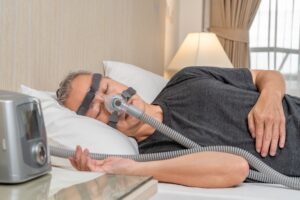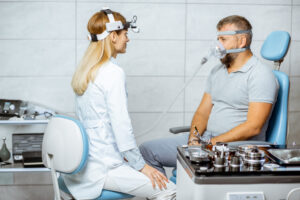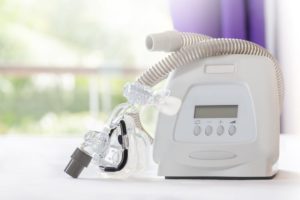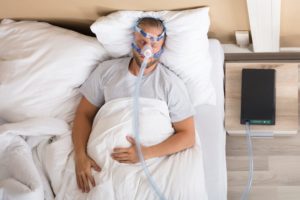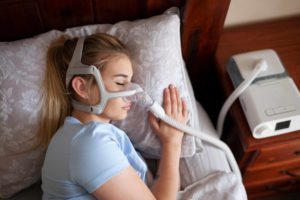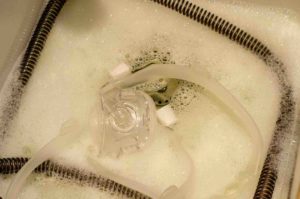CPAP Pressure Settings
- CPAP pressure levels, as determined by a sleep specialist, are typically the lowest amount of pressure needed to to keep the airway open.
- The pressure setting is crucial to treating sleep apnea and reducing symptoms.
- Anatomy and sleep habits factor into the appropriate pressure level.
- Speak to your doctor about recalibration if you experience discomfort, breathing difficulties, and a lack of symptom improvement.
People with obstructive sleep apnea (OSA) stop breathing for brief intervals during sleep due to a blocked or collapsed airway. Continuous positive airway pressure (CPAP) machines are commonly prescribed to treat the condition. The devices deliver pressurized air to help normalize breathing. The right amount of pressure is critical to effective CPAP therapy, as pressure that is too low or too high can create adverse side effects.
We discuss how CPAP pressure is measured, the various factors that determine pressure needs, and the signs and symptoms that suggest your pressure level might need adjusting. It is important to contact your doctor if you believe your CPAP machine settings need to be adjusted. Pressure settings should only be changed under the guidance of a medical professional.
Suspect You May Have Sleep Apnea?
Answer three questions to understand if you should be concerned.
How to Determine the Proper Pressure Setting for a CPAP Machine
Pressure in a CPAP machine is measured in centimeters of water pressure (cm H2O). Settings vary based on the device, but most CPAP machines have a pressure range of 4 cm H2O to 20 cm H2O. The average pressure setting for people with OSA is around 9 cm H2O .
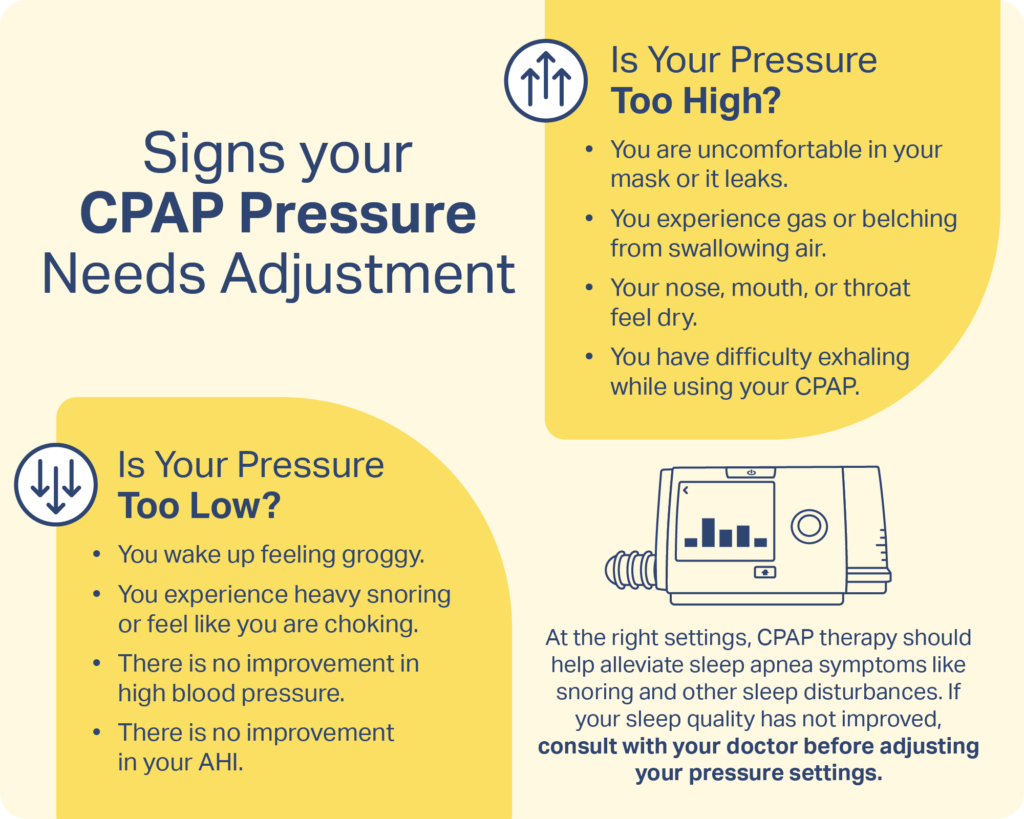
A CPAP titration study is the most common method used to determine an appropriate pressure level. Similar to a sleep study, the assessment is usually done overnight at a sleep center or hospital. Sensors are attached to the sleeper’s body to monitor oxygen levels, breathing, heart rate, brain waves, and body movements. A physician or sleep specialist calibrates CPAP pressure levels until the lowest amount of pressure needed to keep the airway open is determined.
The apnea-hypopnea index (AHI) assesses how many times a person stops breathing or breathes shallowly while asleep, which helps medical professionals determine CPAP pressure settings. Most modern CPAP machines keep track of the sleeper’s AHI, which lets the doctor know if the pressure level needs to be modified.
The sleeper is also fitted for a CPAP mask during the study, which is crucial for effective treatment. CPAP masks come in a variety of styles, including full-face masks, nasal masks, and nasal pillows.After the study, the doctor establishes the optimal pressure range. They can also make recommendations about how to use a CPAP machine.
Factors That Affect the Pressure Setting of a CPAP Device
A number of factors determine the severity of OSA and a person’s appropriate CPAP pressure setting. Some are anatomical, while others relate to lifestyle and sleep habits.
- Anatomical factors: People with craniofacial or upper airway characteristics such as a small lower jaw, a large tongue or tonsils, or a neck circumference greater than 17 inches may be at greater risk of developing OSA and may require higher CPAP pressure levels.
- Deviated septum: A deviated septum limits airflow through the nose, so a higher amount of pressure may be needed to keep the upper airway open.
- Body mass index (BMI): People with obesity are more likely to have extra throat tissue that restricts airflow to the lungs. Pressure requirements tend to increase with a person’s weight , so people who lose a significant amount of weight usually need to lower their pressure setting.
- Nasal allergies: Allergies and nasal congestion can make breathing more difficult, thereby reducing oxygen intake. In addition to calibrating pressure settings, a CPAP machine with a humidifier can sometimes help people with allergies. Regularly cleaning filters can also reduce allergen triggers.
- Sleep position: Back sleeping is generally the least favored sleep position for sleep apnea because the pull of gravity puts pressure on the airway. Back sleepers therefore usually require higher pressure settings. Experts recommend side sleeping for people with OSA because it puts less weight on the upper airway.

How to Tell if Your CPAP Pressure Is Properly Set
Proper CPAP pressure levels help alleviate conditions associated with sleep apnea, such as snoring and sleep disturbances. If you are not experiencing better sleep quality after CPAP therapy, you will probably need to consult with your doctor about adjusting your pressure settings.
Signs Your CPAP Pressure Is Too Low
If you still wake up feeling groggy or unrefreshed after using a CPAP machine, your airway might not be getting enough oxygen to stay open. Heavy snoring, feeling like you are choking, or a lack of improvement in high blood pressure may be signs that your CPAP pressure is too low. If your AHI does not improve once you have fully integrated CPAP therapy into your sleep routine, it may also be an indication that the settings should be adjusted.
Signs Your CPAP Pressure Is Too High
Discomfort is the strongest clue that your pressure setting is too high. Struggling to exhale, nose and mouth dryness, or a burning sensation in the throat are common symptoms of excessive pressure. Some people also experience mask leaks, fluid in the ears, and gas or belching from swallowing air.
APAP Machines
If you continue to have issues with pressure settings on your device, your doctor might prescribe an auto-adjusting positive airway pressure (APAP) machine. This device automatically changes pressure levels based on a user’s breathing patterns. The machine starts at a low setting and then increases according to changes in breathing and airway resistance.
Even though APAP machines automatically adjust pressure levels, a physician still needs to prescribe an ideal pressure range suited to your needs. If the range is off, you may experience adverse side effects.
Frequently Asked Questions
If you consistently experience discomfort during CPAP therapy, or you are not noticing any improvements in your sleep or health, then your CPAP pressure settings probably need to be adjusted. Persistent fatigue, loud snoring, mask leaks, and difficulty exhaling all indicate suboptimal pressure levels. An above-average AHI level suggests that your pressure setting may be too low.
A physician determines proper pressure settings based on your CPAP titration study and AHI. Your pressure might need to be adjusted later if you lose or gain significant weight, change your sleep position, or start taking certain medications. Always speak with your doctor if you suspect your pressure level needs fine-tuning.
If you think your pressure level needs adjusting, contact your doctor’s office and bring your CPAP machine to the appointment. Your doctor will evaluate data from the device and make changes as needed. Pressure settings should only be changed under medical supervision.
Medical Disclaimer: The content on this page should not be taken as medical advice or used as a recommendation for any specific treatment or medication. Always consult your doctor before taking a new medication or changing your current treatment.
References
7 Sources
-
Farré, R., Gozal, D., & Montserrat, J. M. (2021). Alternative procedure to individual nasal pressure titration for sleep apnea. Journal of Clinical Medicine, 10(7), 1453.
https://pubmed.ncbi.nlm.nih.gov/33916282/ -
Strohl, K. P. (2022, October). Obstructive sleep apnea. Merck Manual Professional Version., Retrieved February 8, 2023, from
https://www.merckmanuals.com/professional/pulmonary-disorders/sleep-apnea/obstructive-sleep-apnea -
Yeom, S.W., Kim, M.G., Lee, E.J., Chung, S.K., Kim, D.H., Noh, S.J., Lee, M.H., Yang, Y.N., Lee, C.M., & Kim, J.S. (2021). Association between septal deviation and OSA diagnoses: A nationwide 9-year follow-up cohort study. Journal of Clinical Sleep Medicine. 17(10), 2099–2106.
https://pubmed.ncbi.nlm.nih.gov/34606442/ -
Lankford, D. A., Proctor, C. D., & Richard, R. (2005). Continuous positive airway pressure (CPAP) changes in bariatric surgery patients undergoing rapid weight loss. Obesity Surgery, 15(3), 336–341.
https://pubmed.ncbi.nlm.nih.gov/15826465/ -
Menon, A., & Kumar, M. (2013). Influence of body position on severity of obstructive sleep apnea: A systematic review. ISRN Otolaryngology, Article e670381, 1–7.
https://pubmed.ncbi.nlm.nih.gov/24223313/ -
Kryger, M.H., & Malhotra, A. (2022, August 11). Management of obstructive sleep apnea in adults. In N. Collop (Ed.). UpToDate., Retrieved February 8, 2023, from
https://www.uptodate.com/contents/management-of-obstructive-sleep-apnea-in-adults -
Shafazand, S., & Patel, S. R. (2014). Effect of CPAP on blood pressure in patients with obstructive sleep apnea and resistant hypertension. Journal of Clinical Sleep Medicine, 10(03), 341–343.
https://pubmed.ncbi.nlm.nih.gov/24634635/









